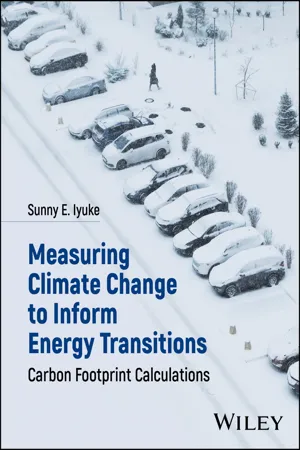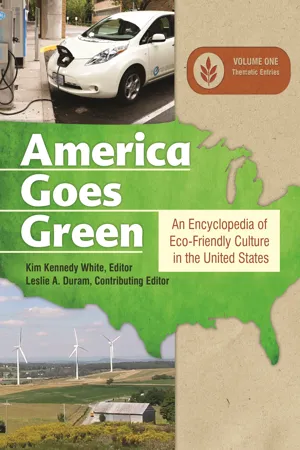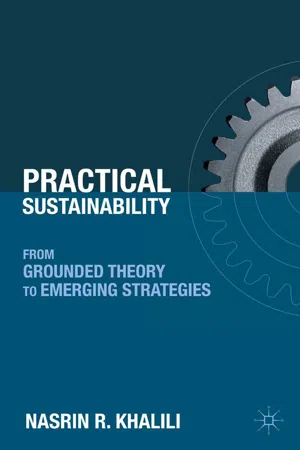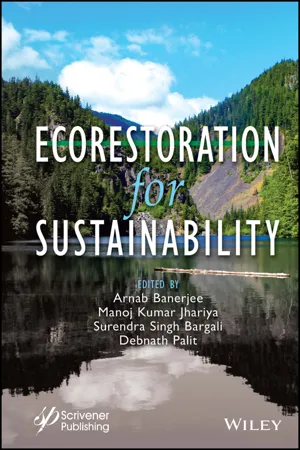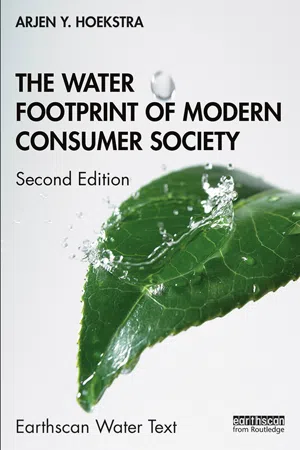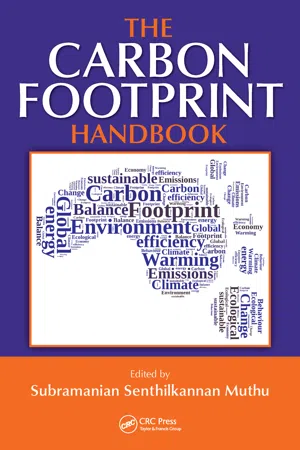Geography
Carbon Footprint
A carbon footprint refers to the total amount of greenhouse gases, specifically carbon dioxide, produced directly and indirectly by human activities. It is typically measured in units of carbon dioxide equivalent and encompasses emissions from activities such as transportation, energy use, and food production. Understanding and reducing carbon footprints is crucial for mitigating climate change and promoting sustainability.
Written by Perlego with AI-assistance
Related key terms
1 of 5
12 Key excerpts on "Carbon Footprint"
- eBook - PDF
Measuring Climate Change to Inform Energy Transitions
Carbon Footprint Calculations
- Sunny E. Iyuke(Author)
- 2024(Publication Date)
- Wiley(Publisher)
1 1 Introduction, Carbon Footprint and Climate Change 1.1 Introduction A Carbon Footprint can be defined as the measure of the impact of human activities have on the environment due to direct or indirect release of greenhouse gases. It estimates the greenhouse gases in pounds or tons of carbon dioxide (CO 2 ). Within the context of total Ecological Footprint, the tonnes of carbon dioxide emissions are expressed as the amount of productive land area required to sequester those carbon dioxide emissions. This refers to biocapacity that is necessary to neutralise the emissions from burning fossil fuels. Thus, measuring the Carbon Footprint in land area shows how much biocapacity is needed to take care of untreated carbon waste and avoid a carbon build-up in the atmosphere. This method of measurement allows addressing climate change challenge in a holistic manner that does not simply shift the burden from one natural system to another because the planet does not provide enough biocapacity to neutralise all the carbon dioxide from fossil fuel and other-natural CO 2 sequestration medium. Levels of CO 2 in the atmosphere are moderately normal, because it helps to keep the planet warm and plays an integral role in many key biological processes, which includes photosynthesis and other biogenic transformations by nature. These earthly transformations produce the so-called Global Carbon Cycle. However, human activities have altered this natural cycle by adding more concentration of CO 2 to the atmosphere, which has overburdened natural ability to remove it. The major culprit in the increased CO 2 concentrations in the atmosphere is the burning of fossil fuels (oil, coal and natural gas), as well as changes in land use from deforestation. The ocean is not left out in sustaining the stability of the carbon cycle by absorbing excess CO 2 from the atmosphere. - eBook - ePub
America Goes Green
An Encyclopedia of Eco-Friendly Culture in the United States [3 volumes]
- Kim Kennedy White(Author)
- 2012(Publication Date)
- ABC-CLIO(Publisher)
EnvironmentCarbon Footprint
A Carbon Footprint is the total amount of carbon dioxide (CO2 ) emitted by an individual, industrial process, or entity (corporation, country, etc.) usually on an annual basis. However, there is disagreement over more specific definitions, units of measurement, and other aspects of the term. The Carbon Footprint has also been referred to as embodied carbon, carbon content, embedded carbon, carbon flows, virtual carbon, greenhouse gas (GHG) footprint, and climate footprint by various authors (citations in Pandey et al., 2011).Roots of the concept can be traced back to the idea of the “ecological footprint” proposed by Rees and colleagues (Rees, 1992; Wackernagel & Rees, 1996), which evaluates the area of land and sea required to support a given human population (expressed in global hectares). Under this concept, Carbon Footprint would refer to the area of land and sea required to store the CO2 emitted by a population or process (mainly through photosynthesis by plants) and would form one component of the total ecological footprint (Kitzes & Wackernagel, 2009). Carbon Footprints have been measured in a different context for decades as part of lifecycle assessment (an examination of the environmental impacts of a process or product through all stages of production) of different processes in business and industry (Finkbeiner, 2009). There is disagreement over whether the Carbon Footprint should be reported or measured straightforwardly as the amount of CO2 produced by the process/entity (metric tons of CO2 ) or in terms of area required for storage, in keeping with the ideas of the ecological footprint. Proponents of the ecological footprint argue that a land-based measurement allows those not familiar with climate science to more easily visualize and understand the impacts of different entities/processes on carbon emissions and thus climate. This utility is seen in the World Wildlife Fund’s “One Planet Living Index” (WWF, 2011), which uses the ecological footprint to focus on the unsustainable use of the world’s resources. Also, expressing the Carbon Footprint in terms of area allows for easier comparison to footprints of other uses of land, which have been calculated for two decades, and may reveal scenarios in which decreasing impacts in one area may increase impacts in another (Kitzes & Wackernagel, 2009). On the other hand, conversion of the Carbon Footprint from mass-based units (metric tons of CO2 ) into the area-based units of the ecological footprint relies on assumptions about the amount of CO2 absorbed by a given area of land, which can be highly variable (depending, among other things, on vegetation type and cover) and difficult to determine. Proponents of mass-based units for the Carbon Footprint do not prefer the area-based units of ecological footprinting because of the additional uncertainty and error introduced by converting mass of CO2 into required land area for CO2 - eBook - PDF
Carbon Footprint Analysis
Concepts, Methods, Implementation, and Case Studies
- Matthew John Franchetti, Defne Apul(Authors)
- 2012(Publication Date)
- CRC Press(Publisher)
3 1 Definitions of Carbon Footprint Analysis and Related Concepts 1.1 Introduction According.to.the.world-. recognized.business.and.environmental.author.Paul. Hawken,. “Sustainability. is. about. stabilizing. the. currently. disruptive. rela-tionship.between.Earth’s.two.most.complex.systems—human.culture.and. the.living.world”.(Hawken.2008) . .Sustainability.strives.to.align.human.prog-ress.and.the.Earth’s.ecological.system.so.that.both.are.operating.in.harmony. and.in.a.synergistic.manner.that.does.not.deteriorate.or.destroy.the.other . . Perhaps. today’s. largest. and. most. dramatic. misalignment. between. human. progress.and.the.Earth’s.ecological.system.is.the.humans’.impact.on.the.cli-mate. .While.many.other.environmental.problems.exist,.climate.change.and. its.associated.implications.on.Earth.rise.in.temperature.is.one.of.the.most. pressing.sustainability.issues.of.our.generation . The. perils. of. climate. change. have. received. increased. worldwide. atten-tion.since.the.early.1990s.via.respected.scientists.and.high-. profile.advocates,. including.former.U .S. .vice.president.Al.Gore . .As.the.Earth’s.average.tempera-ture.rises,.many.scientists.predict.and.are.already.observing.rising.sea.levels,. an.increasing.number.and.intensity.of.violent.hurricanes,.mass.flooding,.and. long. periods. of. drought. accompanied. by. higher. extinction. rates. of. species. and.a.decrease.in.the.worldwide.food.supply . .Scientists.have.attributed.the. climate.change.phenomena.to.increased.energy.and.greenhouse.gas.(GHG). emissions,.primarily.carbon.dioxide.(CO2),.associated.with.human.activity . .At. the.center.of.these.human.activities.is.the.burning.of.fossil.fuels.(e .g., .for.such. things.as.gasoline-. powered.automobiles,.electricity.generated.from.coal,.and. other. fossil. fuel-. burning. activities). and. various. industrial/. manufacturing. processes.that.emit.GHGs . The.public.is.still.largely.unaware.of.the.climate.change.science.and.issues . - eBook - ePub
The Rise and Rise of Indicators
Their History and Geography
- Stephen Morse(Author)
- 2019(Publication Date)
- Routledge(Publisher)
2 e), which reflects the fact that there are many gases that have the capacity to act as greenhouse gases, and, while carbon dioxide tends to receive all the bad publicity, there are others that may be present at much lower concentrations but be far more effective at keeping heat in. Methane, for example, is a greenhouse gas often released as a pollutant in industrial processes and agriculture, and it is far more effective at keeping heat in. The emission of 1 tonne of methane is equivalent in terms of global warming potential to 25 tonnes of carbon dioxide (Wright et al., 2011). Remarkably, there is one gas, sulphur hexafluoride, used for a variety of purposes, including as an insulator in the electrical industry, which is 22,800 times more potent than carbon dioxide as a greenhouse gas (Wright et al., 2011). Thus, 1 tonne of sulphur hexafluoride has the equivalent greenhouse effect of 22,800 tonnes of carbon dioxide.The Carbon Footprint is important in terms of climate change and has received much political and media attention, although arguably nowhere near enough. Efforts are now being brought to bear on reducing our use of fossil fuels by substitution with other renewable energy sources such as solar and wind. We can also calculate the ‘embodied’ carbon in a manufactured product or service and that provides a basis for reduction, perhaps by introducing new processes. However, calculating the Carbon Footprint for a product or service can be complicated, especially as we must consider the carbon emissions from ‘cradle-to- grave’. For example, when we consider the Carbon Footprint of a car it is not just its manufacture we have to consider but also its maintenance and disposal at the end of its useful life; every step in that cradle-to-grave sequence has a cost in terms of carbon emissions, and disposal at the end of the product’s life is no different. However, calculating the embedded Carbon Footprint flowing from all these processes is necessary but challenging, and I do not wish to take the reader down that road (pardon the pun). The interested reader is referred to the excellent introduction to Carbon Footprinting by Mike Berners-Lee entitled How Bad Are Bananas? The Carbon Footprint of Everything (2011). For more technical treatments of the Carbon Footprint and detailed case studies, the reader is referred to The Carbon Footprint Handbook (Muthu, 2016) and Carbon Footprint Analysis - eBook - ePub
Sustainable Products
Life Cycle Assessment, Risk Management, Supply Chains, Eco-Design
- Michael Has(Author)
- 2022(Publication Date)
- De Gruyter(Publisher)
Chapter 5 Environmental footprints and their calculationWhen phrased in a commonly understandable and accessible way, footprints can help producers and users to better understand the resource and energy consumption going along with a product. Areas of high consumption or significant energy loss point to opportunities to improve efficiency by implementing resource management best practices, upgrading systems or developing new technologies. Footprints provide a benchmark to assess the benefits of efficiency improvements and to prioritise the analysis of opportunities.5.1 CO2 footprints
As mentioned greenhouse gas (GHG) emissions must be limited to prevent a rise in average atmospheric temperatures. To this end, most industrialised countries have introduced measures to limit such emissions as well as developed implementable measures to reduce them. To enforce this, an annual percentage reduction is often mandated by law. In order to develop appropriate reduction strategies in a company, it is first necessary to know the GHG emissions in a defined period in numerical terms – especially their main contributions. Consequently, methods are needed to assess the emissions and develop emission factor-related reduction strategies.In the following, the methodology for assessing Greenhouse Gas Protocol (GHP) Scope 1, 2 and 3 emissions is used, and examples of major contributors to emissions are given. In connection with emissions and the increasing likelihood of legal proceedings, penalties and negative publicity, there are sometimes serious risks for each individual company – such risks are presented, structured and provided with examples.5.1.1 GHG emission footprint and CO2 footprint
GHGs are a class of substances known to cause an increase in the Earth’s temperature in the atmosphere. The main GHGs are carbon dioxide, methane, nitrous oxide, sulphur oxide and the fluorinated gases (including hydrofluorocarbons, perfluorocarbons, sulphur hexafluoride and nitrogen trifluoride). Carbon dioxide accounts for 64.3% of GHGs. In order to work with only one figure and to scale the effect of individual gases on the climate, their contribution is converted into the mass of CO2 which, when emitted into the atmosphere, has a comparable effect. This figure is called the “CO2 footprint” or “Carbon Footprint” [1 - eBook - PDF
Practical Sustainability
From Grounded Theory to Emerging Strategies
- N. Khalili(Author)
- 2011(Publication Date)
- Palgrave Macmillan(Publisher)
C H A P T E R 1 1 Approaches to Long- Term Global Sustainability Ecological, Carbon, and Water Footprints Nasrin R. Khalili Human activities, industrial activities, production processes, trans- portation, disposal systems, and every product or service that humans consume has an impact on ecological systems. Greenhouse gas (GHG) emissions from the intensive use of coal-based energy has impacted climates and contributed to global warming and rises in the sea levels. The extensive use of water resources through industrial activities and consumption patterns has compromised the water resources. The con- cept of an ecological footprint is rooted in measuring how the human appropriation of the earth’s resources relates to the carrying capacity of the earth. Prediction, forecasting, and projection, each with its own methods and outcomes, are common elements of ecological assessment approaches. Footprinting is another approach to estimating human impact on the climate, water resources, and ecosystem changes. The term footprint has been effectively used to design assessment frame- works and develop management strategies for addressing ecological impacts for which individuals, organizations, and nations are respon- sible. For example, the full Carbon Footprint encompasses a wide range of emission sources from the direct use of fuels to indirect impacts that can be attributed to an organization’s disposition and practice. Accurate estimation of the “footprints” requires the development of well-structured and detailed assessment methodologies that can guar- antee effective data collection, the proper selection of boundaries and scope of analysis, and disclosure of the results. This chapter discusses the “footprinting” approach and the key factors involved in the devel- opment of effective strategies and protocols for characterizing, measur- ing, and reporting carbon and water footprints, in particular. - eBook - PDF
- Arnab Banerjee, Manoj Kumar Jhariya, Surendra Singh Bargali, Debnath Palit(Authors)
- 2023(Publication Date)
- Wiley-Scrivener(Publisher)
In this context, for- est and other woodland in the world forest is depicted in Figure 8.2 [21]. Similarly, forest covers status in India is also assessed, which is linked with C footprint management (Figure 8.3). As per figure, the forest cover per- centage reflected declining trend from 1987 to 1997. But then onwards, the percentage cover was increased from 1999 to 2019. It was due to better management and conservation practices of forest ecosystem that enhanced higher biomass productions along with better C sink potential for reducing C footprints. Thus, adopting sustainable forest management (SFM) ensure better regeneration, higher forest cover, biomass, and C sink for managing C footprints in the country [22, 23]. 8.3 Carbon Footprint: A Conceptual Framework The concept of C footprint is new which is strongly linked with C accu- mulation in atmosphere beyond the optimum level. Among the GHGs, only CO 2 (carbon dioxide)is gaining wide attention among climate scien- tists, policy makers, stakeholders, researchers, etc. C footprint refers to the GHGs emissions including amount of C in the atmosphere due to vari- ous anthropogenic activities [24]. These activities release C in the atmo- sphere which leads to warming effects and climate change phenomenon [25, 26]. C flow, movement and flux in the atmosphere are affected by var- ious human activities [7, 27]. The study of C footprint reflects the level of climate change and its consequences on biodiversity and ecosystem ser- vices [28]. C footprints mediated climate change leads to unsustainable environment and ecological instability. Surprisingly, rising C footprints affects soil-food-climate security from local to global level. This will not only minimize ecosystem services but also affects sustainable development goals [29]. Several anthropogenic activities including deforestation also promotes C footprint by releasing C into the atmosphere. - eBook - PDF
Alligators in the Arctic and How to Avoid Them
Science, Economics and the Challenge of Catastrophic Climate Change
- Peter Dorman(Author)
- 2022(Publication Date)
- Cambridge University Press(Publisher)
Measurement that connects the policies we implement to cli- mate outcomes is the place to begin. By the end of the chapter it will be clear what this means: exactly what we need to know in order to take effective action and assess how well it’s working. The Footprint Fetish During the summer of 2020, while the coronavirus pandemic was clamping down on all forms of travel, readers of the New York Times were presented with a quiz on Carbon Footprints containing this question: “You have a midsize car and you’re environmentally con- scious, so you set yourself a strict limit of 100 miles per week. If you switched to a hybrid car, how many miles could you drive while still producing the same amount of greenhouse gases?” 2 It’s a complex problem; to answer correctly we would need a plethora of information that would change from time to time and place 54 / Measurement: Myths and Distractions to place. (We will see this in greater detail later.) Being a climate hero isn’t easy! But this is what each of us is supposed to be able to figure out, right? Overall, what’s your Carbon Footprint? Surely, this isn’t the first time you’ve been asked this question; you’ve probably asked it of yourself. Go through all your possessions, the size and insulation of your house, how much you drive and whether you take frequent airplane trips. There are online calculators to help you condense your hundreds of lifestyle choices into a single number, your personal contribution to the climate problem. 3 For many environmentalists, personal footprints are a measure of moral virtue. They see the world divided into the solid citizens, the ones who are always looking to shed a few ounces of carbon guilt, and the villains who shirk personal sacrifice. The virtuous drive Priuses, while the evildoers can be found in big SUVs, pickups and other incarnations of fossil fuel profligacy. - eBook - ePub
- Arjen Y. Hoekstra(Author)
- 2019(Publication Date)
- Routledge(Publisher)
et al. , 2012; Ercin and Hoekstra, 2014).Eco-efficiency
Producers compete for natural resources and for their share in the limited assimilation capacity of the Earth. Companies compete, for example, for land, water use rights, carbon emission quota and wastewater discharge permits. To get the highest benefit per unit of natural resource consumption and unit of pollution, footprints of activities and products need to be minimized. Eco-efficiency means a small footprint per unit of product. The environmental footprint has thus become a key performance indicator in environmental management and a way to demonstrate corporate social responsibility (Herva et al. , 2011; Čuček et al. , 2012).In practice, companies tend to formulate reduction targets regarding their direct footprint, thereby ignoring their indirect footprint, which is often much bigger (Matthews et al. , 2008). The indirect water footprint of beverage companies, for example, can comprise about 99 per cent of their total water footprint (Ercin et al. , 2011). This issue is being recognized and addressed in footprint standards. For instance, the corporate value chain standard of the Greenhouse Gas Protocol (WRI, WBCSD, 2011) provides guidance for companies and other organizations to report greenhouse gas emissions from all supply chain, operational and disposal activities (the ‘value chain’) associated with their business. The global water footprint standard by the Water Footprint Network gives such guidance as well (Hoekstra et al. , 2011). However, setting reduction targets for their supply-chain footprint remains a major challenge for most companies. Current research focuses on the practicality of data compilation and reporting, the completeness of supply-chain coverage and the accuracy and transparency of results (Herva et al. , 2011; Huang et al. , 2009). These issues need to be addressed to enable meaningful comparisons between companies and benchmarking based on the best available technology and practice (Wiedmann et al. , 2009). Another challenge is to internalize the costs related to the environmental footprint of products in their price, for example, by charging carbon and water taxes along the supply chain, or a general environmental tax on final products (e.g., a tax on meat). Yet another challenge is to develop a better understanding of trade-offs between different footprints. Reducing the Carbon Footprint by moving towards bioenergy, for instance, will inevitably increase the land and water footprint (Gerbens-Leenes et al. - Jiri J Klemes, Jiří Jaromír Klemeš(Authors)
- 2015(Publication Date)
- Butterworth-Heinemann(Publisher)
For groundwater, this is the seepage rate (given by local precipitation). For emissions into the air, the natural exchange of substances between forests and air per unit area is taken as a basis of comparison between natural and anthropogenic flows. Different emissions to air are not weighted, because only the largest dissipation areas are to be considered. Lower area consumption emissions may be dissipated without violating the principle that anthropogenic mass flows must not alter the qualities of local compartments (Sandholzer and Narodoslawsky, 2007). Human footprint The human footprint measures energy quantities, resources, and products consumed by a human during his/her lifetime and includes, for example, the number of food “pieces,” the volumes of fuel and water, and the mass of waste (National Geographic, 2014b). Human footprint evaluates everything humans eat, use, wear, buy, and discard during their lifetime (Kirk, 2011). Human footprint is also a measure of transformation, integrating information regarding human access, settlement, transformation of land use/land cover, and development of energy infrastructure (Trombulak et al., 2010). Waste footprint Waste footprint is the amount of waste produced by sourcing ingredients and materials, manufacturing and processing, and transportation (Thinking Ahead, 2011). It also represent the environmental, economic, and social impacts that result from waste that humans create (HEC Global Learning Centre, 2009). Emergy footprint Emergy footprint combines the EF calculation and emergy analysis (Zhao et al., 2005)- eBook - PDF
- Subramanian Senthilkannan Muthu(Author)
- 2015(Publication Date)
- CRC Press(Publisher)
For example, Kim et al. (2010) collected CF data from the survey measuring home energy use and travel behavior of 2064 households in 8 cities in Gyeonggi-do, Korea. Kim and Kim (2013) ana-lyzed the effects of the net and gross population densities on CF of residents at an intraurban scale in the capital city of Seoul, Korea. In this study, individual CF of residents was calculated by convert-ing the carbon intensities of home and travel fossil-fuel use of respondents to the unit of metric ton of carbon dioxide (tCO 2 ) by multiplying the conversion factors equivalent to the carbon intensities of each energy source, such as electricity, natural gas, and gasoline. 180 The Carbon Footprint Handbook Second, Kim and Dall'erba (2014) analyzed the spatiotemporal distribution of CO 2 emissions from agricultural activities on cropland across U.S. counties. Based on a novel database, the authors inves-tigate how crop production output (measured in carbon) relates to CO 2 emitted in the production and transportation process of the inputs needed for crop production by using various spatial statistics. CF is an important notion for sustainable development as well as for climate change mitiga-tion. As shown in the case studies, CF could be measured and applicable at variety of spatial units, including but not limited to, counties and neighborhoods. Although only three case studies were introduced in this chapter, these examples may provide new perspectives on CF applications in planning and geography. Furthermore, additional concerns about consumptions of food, goods, and services (e.g., Kim et al. 2011) could be included in CF calculation in fields of urban planning and geography. REFERENCES Ahn KH. 1998. A study on the correlation between variables of urban form and energy consumption. The Korea Spatial Planning Review 27:19–30. Alberti M. 1999. Urban patterns and environmental performance: What do we know? Journal of Planning Education and Research 19(2):151–163. - eBook - PDF
- Raumjit Nokkoul(Author)
- 2011(Publication Date)
- IntechOpen(Publisher)
3 Ecological Footprint and Carbon Footprint of Organic and Conventional Agrofoods Production, Processing and Services Iuliana Vintila Dunarea de Jos University Galati Romania 1. Introduction The Ecological Footprint (EF) measure the natural capital demand of human activities (Wackernagel and Rees, 1996 and 2002) and reveal the sustainability of consumption patterns on individual, local, national and global scales (WWF, 2008). The ecological footprint measure the natural capital demand of human activities (Wackernagel and Rees, 1996) and reveal the sustainability of consumption patterns on individual, local, national and global scales (Arrow, 2002). Ecological footprint model assumes that all types of energy, material consumption and waste discharge require productive or absorptive capacity of a finite area. Six types of ecological biologically productive area (arable land, pasture, forest, sea space, built-up land and fossil energy land) are used to calculate the Ecological Footprint and ecological capacity (Wackernagel et al., 2002). The ecological footprint estimates the ‘‘minimum land necessary to provide the basic energy and material flows required by the economy’’(Wackernagel and Rees, 1996). The consumption elements are converted into a single index: the land area to sustain the lifeliving among human consummation groups. The area of land or sea available to serve a particular use is called biological capacity (biocapacity) and represents the biosphere’s ability to meet human demand for material consumption and waste disposal. The degree of unsustainability is calculated as the difference between actual available and required land. In the original ecological footprints model created by Wackernagel and Rees (1996) and reformulated by Chambers et al. (2000), the land areas included were mainly those directly required by households with autoconsumation life style.
Index pages curate the most relevant extracts from our library of academic textbooks. They’ve been created using an in-house natural language model (NLM), each adding context and meaning to key research topics.
